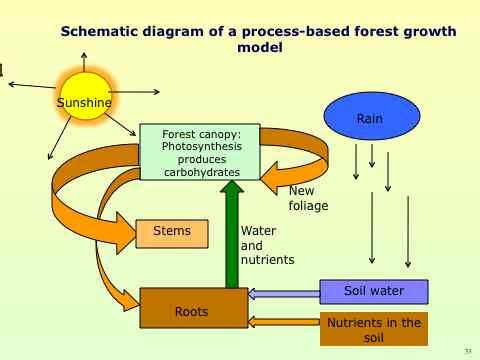- Data Basin |
- Use Cases |
- Physiological Principles Predicting Growth (3-PG) Model
Physiological Principles Predicting Growth (3-PG) Model

Forest Productivity Model
The Physiological Principles Predicting Growth(3-PG, Landsberg and Waring 1997) model is a generalized forest carbon allocation model that works with any forest biome. In 2014, this model was used in the Integrated Scenarios project to simulate a 50 year old conifer forest under climate change forcings from the IPCC’s CMIP5 (Coupled Model Inter-Comparison Project, phase 5).
The Model
The 3-PG model employs a light-use-efficiency based photosynthesis algorithm to simulate the change in net primary production as a forest ages. In this algorithm, 3-PG calculates the radiant energy absorbed by forest canopies and converts it into biomass production. The efficiency of radiation conversion is modified by the effects of nutrition, soil drought, atmospheric vapor pressure deficits and stand age. The carbon produced by the canopy is allocated to leaves, stems and roots, using dynamic equations that update the state of the system on a monthly time step. The utilized portion of the solar radiation is decided using models for stomatal closure (temperature extremes), soil available water(precipitation, soil water, evapotranspiration) and freezing temperature effects.
The model contains four simplifying assumptions that make its computations practical:
-
If only sunlight limits production, growth increases linearly as the canopy of leaves intercepts and absorbs more light.
-
Half of gross photosynthesis is respired away in the construction of new growth and in the maintenance of live tissue
-
Monthly mean maximum and minimum temperature data are sufficient, with knowledge of a site's location, to derive good estimates of incident solar radiation, frequency of frost, and humidity deficit of the air, which, along with monthly precipitation, are the essential climate variables required to drive the model.
-
The model reduces photosynthesis as a simple function of stand age rather than accounting for reductions in water transport through roots, stems, and branches

Figure: Schematic Diagram of a Process Based Forest Growth Model (Courtesy of Richard Waring)
3-PG Inputs
The 3-PG model uses relatively simple and readily available inputs such as species growth tables, latitude, aspect, weather records, edaphic variables, stand age, and stand density to derive monthly estimates of gross primary productivity, carbon allocation, and stand growth. Monthly weather data is used to constrain photosynthesis based on high daytime atmospheric vapor pressure deficit, subfreezing temperatures, suboptimal temperatures, and soil water deficits. The monthly weather data needed is the average incoming photosynthetically active radiation, mean daytime vapor pressure deficits, min/max temperature, precipitation and estimates of soil water storage capacity and fertility. Initial tree populations are specified and changes in stem populations calculated using a well-established mortality function.
3-PG Outputs
3-PG monthly outputs include transpiration and evaporation. 3-PG yearly outputs include tree density, leaf-litter fall, stem biomass and volume, average stem diameters, stand basal area and leaf area index.
-
Net primary production is the rate of organic biomass growth or accumulation by plants after accounting for energy lost due to cellular respiration and maintenance of plant tissue..
-
Leaf area index (LAI) is the ratio of upper leaf surface area to ground area (for broadleaf canopies), or projected conifer needle surface area to ground area (for coniferous plants) for a given unit area.
-
Stem biomass is the mass of carbon storage in wood for stems.
Data Uses:
3-PG can be used to evaluate site potential and analyze the probable effects of varying growing conditions or management actions such as thinning, defoliation, the effect of adding fertilizer to change soil fertility and irrigating to change Available Soil Water (ASW), along with the effect of rising atmospheric CO2. In recent iterations, the 3PG model has been linked to satellite imagery of canopy photosynthetic capacity to model forest growth across landscapes (Coops et al. 1998). It has considerable potential as a tool for estimating carbon sequestration by forests and plantations.
References
Coops, N.C., R.H. Waring, and J.J. Landsberg. (1998). The development of a physiological model (3-PG S) to predict forest productivity using satellite data. In: G. Nabuurs, T. Nuutinen, H. Bartelink, M. Koorhonen, eds. Forest scenario modelling for ecosystem management at landscape level: 173 -191. EFI Proceedings.
J.J. Landsberg, R.H. Waring. A generalised model of forest productivity using simplified concepts of radiation-use efficiency, carbon balance and partitioning. Forest Ecology and Management. Volume 95, Issue 3, 1 August 1997, Pages 209–228.
- Citation
- Katherine Hegewisch. 2015. Physiological Principles Predicting Growth (3-PG) Model. In: Data Basin. [First published in Data Basin on Sep 18, 2015; Last Modified on Apr 28, 2016; Retrieved on Dec 16, 2025] <https://databasin.org/articles/2c2f9b54f053425fb97ed75895c364fd/>
About the Author
Katherine is a postdoctoral fellow working under Dr John Abatzoglou, a climatologist in the Department of Geography at the University of Idaho. Katherine's background is in computation and statistics. Katherine has been working on the statistical downscaling of global climate model(GCM) outputs...

